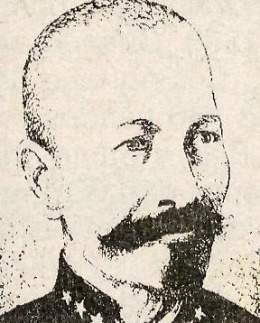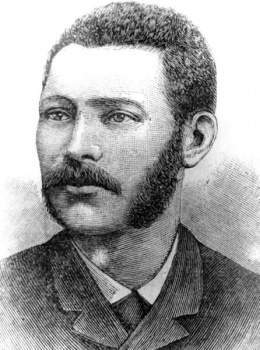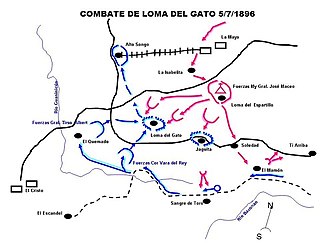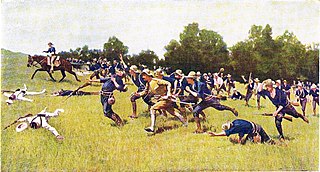
Lt. General José Antonio de la Caridad Maceo y Grajales was a Cuban general and second-in-command of the Cuban Army of Independence.

The Cuban War of Independence, also known in Cuba as The Necessary War, fought from 1895 to 1898, was the last of three liberation wars that Cuba fought against Spain, the other two being the Ten Years' War (1868–1878) and the Little War (1879–1880). The final three months of the conflict escalated to become the Spanish–American War, with United States forces being deployed in Cuba, Puerto Rico, and the Philippine Islands against Spain. Historians disagree as to the extent that United States officials were motivated to intervene for humanitarian reasons but agree that yellow journalism exaggerated atrocities attributed to Spanish forces against Cuban civilians.
The chronology of the colonial time of Cuba is about the Spanish colonial period in Cuba, and the efforts to obtain independence from the Spanish Empire and includes history from the "discovery" of the island by Christopher Columbus to the Spanish–American War.

Bartolomé de Jesús Masó Márquez was a Cuban politician and military, patriot for Cuban independence from the colonial power of Spain, and later President of the República en Armas.
The First Eastern Campaign was a military campaign that took place between early May and late August 1895 in Oriente Province of Cuba, in the Cuban War of Independence.

Jesús “Rabí” Sablón Moreno was a Cuban soldier and patriot of the 19th century.

José Marcelino Maceo Grajales was a Cuban Independence Activist and patriot of the 19th Century.

Pedro Agustín Periquito Pérez Pérez, better known as Periquito Pérez was a Cuban independence political activist.

The Battle of Peralejo was a military confrontation between Cuban independence rebels, under the command of Major General Antonio Maceo against the forces of the Spanish Army, under the command of Captain General Arsenio Martínez Campos, which was part of Maceo's First Eastern Campaign during the Cuban War of Independence.
The Battle of El Indio Sao was a battle of the Cuban War of Independence which took place on the 31st of August 1895 in Oriente Province of Cuba.

Agustín Cebreco Sánchez, was a Cuban major general and politician of the Mambí Army.
The Invasion from East to West took place on the island of Cuba, and began on October 22, 1895, in Mangos de Baraguá, in the former province of Oriente. It was organized and directed by Antonio Maceo Grajales and Máximo Gómez. The Liberation Army, guided by the firmness of taking the fight against Spanish colonialism to all corners of Cuba, starred in one of the most relevant events in Cuban history. In the midst of the "Cuban War of Independence", inspired by José Martí, that campaign responded to the old desire of the insurgent generals Maceo and Gómez. These launched the strategy of limiting the liberation struggle to the eastern territory of the Island, but rather extending it throughout the entire Cuban territory to force Spain to fight simultaneously in the six provinces that the country had at that time, in order to weaken it on all fronts.

Francisco Adolfo "Flor" Crombet Tejera was a Cuban patriot and participated in the three independence conflicts. He was appointed head, in commission, of the division of Cuba and Bayamo and was Major General. He landed with Antonio Maceo Grajales for "Duaba". He participated in the Ten Years' War and protested with Maceo in Mangos de Baraguá in defense of the total and definitive independence of Cuba.
The Battle of Iguará was a battle of the Cuban War of Independence which took place on December 13, 1895 in the Santa Clara Province, Cuba.
The Battle of Coliseo was a group of military actions carried out in the surroundings of the town of the same name, Matanzas Province, Cuba on December 23, 1895 during the Cuban War of Independence.
The Battle of Calimete was a battle of the Cuban War of Independence on December 29, 1895, which was led by Cuban independence activists Máximo Gómez, Antonio Maceo and later on, Serafín Sánchez.

The Battle of Loma del Gato took place during the Cuban War of Independence on July 5, 1896 at Santiago de Cuba, Oriente Province. It is notable for the death of Mambí General José Maceo.

José Miró Argenter, also known as José de Miró Argenter was a Cuban brigadier general and author of Catalonian origin who served during the Cuban War of Independence. He was a division General of the Cuaban Liberation Army and a member of Antonio Maceo's General Staff. In 1899 he published his work Cuba: Chronicles of the War, which was a book on his participation in the Cuban War of Independence.

The Second Eastern Campaign was a military campaign that took place between August 1 to 12, 1898, in the Oriente Province of Cuba during the Cuban War of Independence. It was the shortest military campaign of the entire war and it was the one that marked the end of Spanish reign in Cuba and the Spanish Empire in Latin America.

The Cuban Liberation Army, colloquially known as the Mambí Army was an insurgent army which was formed in the last third of the 19th century and fought for independence from Spain and the abolition of slavery. It first saw combat in the Ten Years' War (1868-1878) under the command of Carlos Manuel de Céspedes, Ignacio Agramonte, and Carlos Roloff. The independentists were decentralized and operated within their own regions autonomously of each other, until the Assembly of Guáimaro established the Republic-in-Arms of Cuba and the Liberation Army's command structure. After the Pact of Zanjón, a brief uprising called the Little War saw Major-Generals Calixto García and Antonio Maceo lead the Army of Liberation in another attempt at independence and the abolition of slavery, though unsuccessfully. Finally, during the War of Independence, the Liberation Army was once again organized to fight against the Spanish colonial government. The Liberation Army would reach its highest count of active members in the Spanish-American War, when an imminent Cuban-American victory caused hitherto anti-independence elites to join the Liberation Army. These recruits were nicknamed "Sunflowers" because they "point to where the sun is shining".












